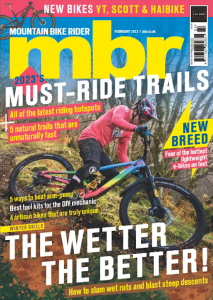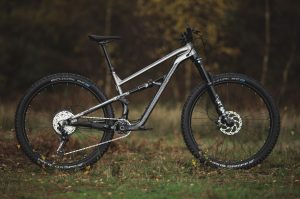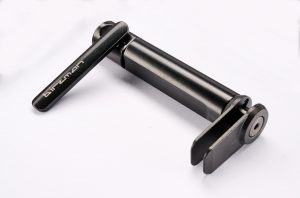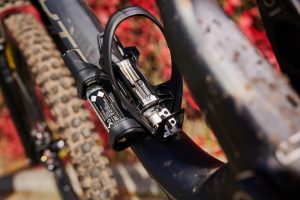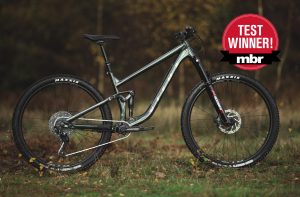Short on travel but big on geometry, we review the best down-country mountain bike rigs that blend the speed of an XC bike with the capability of trail bike and are at the forefront of the latest wave of all-round mountain bikes.
Short on travel, light on weight, but big on geometry, the best down country mountain bike rippers give you everything you want and nothing you don’t. Fast and fun in a lightweight, efficient package that can cover ground with minimal fuss. What is a down-country bike? And what isn’t? Pumped up XC bikes? XXXC bikes? Down country? XC/DC? Whatever. They’re lightweight, sub-130mm travel bikes with progressive geometry.
Unlike the best mountain bike classifications, down-country is not just signified by how much travel it has. Down-country bikes are all about the combination of short travel, minimal mass and progressive geometry. But how much travel is ‘short’ travel? And what does ‘progressive’ geometry really mean? What makes the best down-country bikes more suitable for modern day use than one of the best cross-country XC mountain bikes? Skip to the bottom to find out the answers, or browse our down-country picks below.

Transition Spur
Transition Spur
Exceptional lightweight trail bike
Wheel size: 29in | Frame: Carbon, 120mm travel | Weight: 11.25kg (24.8lb) | Rating: 10/10
Pros: Perfect blend of speed and control Cons: Not the most robust build if you’re carrying some timber.
Hubba-hubba. Whit-woo. And so forth. Gosh darn it, the new Transition Spur may well take the crown for the best looking down-country mountain bike. Just look at it. But beyond the sharp but friendly aesthetics there lies a very good example of a modern short travel mountain bike. Transition is very much ‘the little brand than can’. The best-realised ‘down-country’ bike we’ve ever tested and the one we all covet if we were spending our own cash.
Read our full test review of the Transition Spur

Evil Following
Evil Following V3
Generates more cornering G-forces and sheer boost-and-pop than any other bike we’ve ridden
Wheel size: 29in | Frame: Carbon, 120mm travel | Weight: 12.9kg | Rating: 10/10
Pros: That complicated-looking linkage array is worth it Cons: Boost 157 not well-liked by some
Okay, we’re only into the second bike on the list and we’re breaking the down-country ‘rules’ already. This bike comes with a 130mm travel fork (shock horror) but we’re including it here because we feel Evil deserves muchos kudos for being right at the front of the whole rad short travel bike phenom. This is still one of the very best examples of the experienced enduro racer’s down-country rig. Agility overload, combined with float-then-pop suspension.
Read our full test review of the Evil Following V3 GX Eagle

Integrated suspension system conceals the RockShox NUDE 5 shock inside the full carbon frame
Scott Spark
Ruthless in its efficiency
Wheel size: 29in | Frame: RC Carbon HMX, 0/80/120mm | Weight: 11.12kg (24.52lb) | Rating: 9/10
Pros: Super clean lines reflect the bike’s rapidity. Cut-throat dynamism. Cons: Suspension could be a touch more supple in Descend mode.
Fast, efficient and responsive, the new Scott Spark RC is an outstanding XC race bike. With 120mm of travel, it has the suspension to tackle the toughest courses, but reserves a sharpness to its pedaling response that won’t leave you languishing in the finish-line sprint. It’s stiff too, so if you’re not under 65kg dripping wet, you’ll still have the confidence to charge hard. Scott has missed a trick with it’s TwinLoc remote though, as we think the Spark RC would be even faster if the suspension was a touch more active in the 120mm Descend mode. Even so, this is a scorchingly fast XC bike with a helluva pedigree that can still hold its own in the right hands against most modern trail bikes on gnarlier terrain.
Read our full test review of the Scott Spark RC WC AXS

Trek’s Top Fuel 8 offers a high-octane ride
Trek Top Fuel
Explosive trail weapon
Wheel size: 29in | Frame: OCLV Carbon or alloy, 120mm travel | Weight: 14.46kg | Rating: N/A
Pros: Sublime suspension, playful handling, fantastic size range, internal storage. Cons: Not particularly light for the intended use, inconsistent Shimano brakes on our test bike.
Not as sharp or ruthlessly efficient as a YT Izzo, softer and more approachable than a Transition Spur, this new Trek Top Fuel brings high-octane entertainment and understated performance to the type of trails most widely ridden in the UK. Even if the looks might not leave a lasting impression, it’s unforgettable to ride.
Read our full test review of the Trek Top Fuel 8

YT Izzo Uncaged 7
YT Izzo
Rapier-sharp speed and agility
Wheel size: 29in | Frame: Carbon, 120mm travel | Weight: 11.4kg | Rating: N/A
Pros: Acutely responsive and ruthlessly efficient. Agile and accurate. Good spec for the price. Cons: Nowhere to hide. Traction/grip is not the best. Doesn’t really need the remote lockout. Front tyre could be more aggressive.
A bike that’s trying to cover a multitude of bases means it will have made compromises along the way, and if you’re a racing whippet that wants to go fast and shred hard, the Izzo might not be the perfect foil alongside bikes like the softer Spur and lighter Blur. But if you’re not 65kg wringing wet, enjoy a bit of self-flagellation and fancy something seriously rapid, then the Izzo might just be your new dominatrix. Bring out the gimp.

Orange Stage Evo
Packs big bike geometry into a nimble 120mm package
Wheel size: 29in | Frame: 6061-T6 Aluminium, 120mm travel | Weight: 13.83kg (30.49lb) | Rating: N/A
Pros: Incredibly well-poised handling belies its modest weight Cons: It’s arguably a trail bike
The old Orange Four is no more it seems. In its place is a scaled-down version of its trail-slaying Stage models. Once again the fork travel (130mm) may step over the down-country lines, but seeing as we only measured the rear travel at 116mm, we’re calling it quits. Despite clearly being on the down-country bandwagon, the Stage Evo is unashamedly its own thing. Like all Oranges, it will either appeal a lot, or you won’t see the appeal at all. After day on one, we were definitely in the former camp.
Read our first ride review of Orange Stage Evo

Santa Cruz Tallboy
Santa Cruz Tallboy
Blends big bike geometry with small bike travel
Wheel size: 29in | Frame: Carbon CC, 120mm | Weight: 12.53kg (27.62lb) | Rating: N/A
Pros: Still one of the longest-feeling 120mm travel bikes Cons: Needs a pretty skilled rider to avoid prat-falls
Despite its desirability level forever being premium, Santa Cruz is often ever so slightly behind the cutting edge. Not so with the Santa Cruz Tallboy. In fact, the very first version of the Tallboy way-back-when in 2009 was probably the bike that tipped a lot of bike media journos into a love affair with 29in wheels that has held sway ever since. More than any other bike name, the Tallboy is to blame for down-country. The new version continues to lead the way.
Read our first ride review of the Santa Cruz Tallboy

Specialized Epic Evo
Specialized Epic Evo
Dialled option from the Big ‘S’
Frame: FACT 11m Carbon | Weight: 10.70g (23.59lb) | Rating: 8/10
Pros: Ditching the chainstay pivot has only improved its speed. No more Brain makes suspension set-up easier. Cons: Seat tube lengths are still more in tune with road bikes than modern trail bikes
The Epic Evo takes the quintessential XC bike and puts it through boot camp to emerge faster and more capable than ever. There’s an extra 20mm travel up front compared to the Epic, which helps slacken the razor-sharp steering to make it less twitchy at high speeds. At the back there’s 10mm more travel, which helps with comfort and traction. The carbon frame is sleek with a classic shape and an excellent choice of sizes, so you can be sure to get the right fit. You’ll need tighter reins compared to a true down-country bike, but the Epic Evo is more than capable of winning on Sunday, shredding on Monday.
Read our full test review of the Specialized Epic Comp Evo

As soon as you release the reins, the Spur starts to gallop
What is a down-country mountain bike?
A few rules to help categorise a down-country bike. The first rule is that these rules are made to be broken!
Nothing over 120mm
No more than 120mm of suspension travel at either end. The archetypal down-country bike should have closer to 100mm of rear travel. And if there’s a 130mm travel fork up front, it’s ruled out. Usually. There are some outliers than we allow into the down-country fold. Otherwise the whole thing just gets far too close to a regular trail bike. So, no Norco Optic or Nukeproof Reactor 290c ST. Too trail-bikey.
Having said that, neither rear travel nor fork travel should have less than 100mm. Save that for XC race bikes.
Nothing steeper than 67°
We’re talking head angles here. Non-XC geometry is the key thing that must be included if a bike is to be classed as down-country. And though we say ‘geometry’ we really mean head angle. There’s currently not much consensus about the other angles and measurements on down-country mountain bikes; they don’t all have longer reach numbers, nor steeper seat angles, nor super low BBs.
But the head angle on all down-country bikes cannot be steeper than 67°. 66° is arguably the most commonly seen number.
Big wheels only
You’ll not find any 27.5in wheels here. Nope, not even just on the rear as a modern mullet setup. 29in wheels rule the down-country roost.
What’s the difference between an XC bike and a down-country bike?
That’s a contentious one, and mostly a matter of opinion. But in our view, a down-country bike is a trail bike with the weight and travel of an XC bike, whereas an XC bike generally has steeper geometry, a lower front end and a stronger bias towards efficiency. Using, for instance, remote lockouts to maximise power transfer on smooth surfaces. The lines are blurred, however, and some XC bikes are closer to down-country bikes than others. And the components used also make defining bikes more difficult. Some down-country forks have all-out XC race forks. Some have middling 34-35mm stanchions. Some have four-pot brakes and huge rotors. Others just have 180/160 twin-pot combos. Some have dinky stems. Some still sport stems over 50mm long.
It’s the finishing kit that is perhaps key to the down-country experience. And expectation. Some down-country bikes appear to be aimed at ex-XC lycra-heads looking for more fun and less sketch in their rides. Other down-country bikes are aimed at the all-out aggro brigade who have tired of their super-capable enduro bikes and wish to inject a level of limit to their Sunday shredding.
In our opinion, it’s the latter type of down-country bike that is most interesting and exciting. But more capable XC bikes also provide unique thrills, and that injection of effortless pace never gets boring.
Slacker, longer, lower… shorter. Bring it on.


